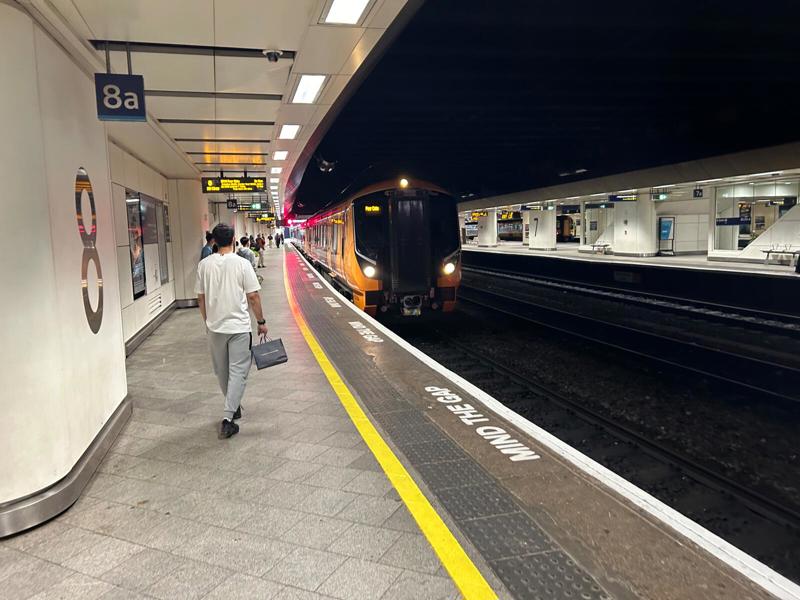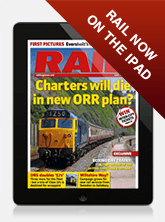In RAIL’s latest undercover assessment of how the railway treats its passengers, our Mystery Shopper travels around popular Midlands destinations with five different train operators. Does the railway deliver?
In this article:
- Station and train facilities vary, with some providing modern amenities and others plagued by dirt, delays, and overcrowding.
- Popular tourist destinations like Leamington Spa and Stratford-upon-Avon highlight both the potential and shortcomings of regional rail connectivity.
- Ticket checks are rare, catering is dwindling, and excessive announcements distract from an otherwise scenic and accessible network.

For this mystery shopper, RAIL examines the network in the heart of England, with a plan to visit some popular destinations: Leamington Spa, Stratford-upon Avon, Hereford and Shrewsbury.
All have plenty of attractions for the leisure traveller or tourist. But how well does the railway deliver passengers to these destinations?
A West Midlands Day Ranger covers these towns, plus a host of others. Priced at £34.00, it covers a wide area - use it enough, and it’s good value. However, references on the National Rail website suggested it would cost £31.70 - so that’s not a great start!
This Rover ticket can take you as far north as Crewe (via the Trent Valley as well as directly from Wolverhampton and over the Cannock Chase line), and south to Northampton. Its other extremities are Gobowen and Redditch, and it covers Avanti West Coast, Transport for Wales, Chiltern Railways and CrossCountry.
Like most Rover tickets, it’s valid from 0900 on weekdays and all day on Saturdays, Sundays and Bank Holidays. Our test takes place on a Monday.
Pricey parking
We begin in the east at Nuneaton - a busy junction served mostly by regional operators, plus some fast AWC trains.
The station was remodelled in 2006 by reinstating the flyover to allow CrossCountry trains to avoid the West Coast Main Line, and these XC services now have their own platforms ‘bolted on’ the side to give seven platforms.
Nuneaton is served by West Midlands Trains’ two operators. London Northwestern Railway has its Class 350s (and soon ‘730/2s’) on the semi-fast Euston to Liverpool services, while West Midlands Railway runs local services to Leamington Spa - our first journey.
Parking at the station costs £9.10 on a weekday peak. £6.40 at weekends seems pretty steep, too. Hopefully Great British Railways will address this, otherwise how does this encourage people to travel by train? Payment is via machine or apps.
RAIL’s first train is the 1037 ‘local’ to Leamington Spa, formed of a new CAF Class 196 two-car diesel multiple unit (DMU), 196003. This journey of just under 20 miles takes 38 minutes but nevertheless demonstrates the investment that has taken place in these railways under both BR and more recently.
The Nuneaton-Coventry line was freight-only until 1987. Three intermediate stations were later opened in 2016 (Bermuda Park), 1988 (Bedworth) and 2016 (Coventry Arena) respectively, while south of Coventry, Kenilworth followed in 2018.
Being new, our train is in good condition, and there are both three-pin plug and USB sockets. There’s no problem finding a seat, albeit this is off-peak.
A smattering of passengers board at most of the intermediate stops, and we arrive at Coventry a minute early. Compared with older trains, the ‘196s’ have rapid acceleration and braking, which should enable journey times to be cut in future.
As a reminder of that investment, this service started with a single-car Class 153, so it now has both more seats and greater speed.
Without having had our tickets checked, we arrive at Leamington Spa. One irritation is that the QR code on RAIL’s Rover ticket won’t open the barriers, so we must rely on staff.
Leamington’s station retains much of the charm of the Great Western Railway (the original, not the current version). It’s a lovely place, with a waiting area, refreshment room and other facilities. Just what you want.
Our next train is Chiltern Railways’ local to Stratford-upon-Avon. A two-car Class 168 (168323), it dates from 2000 but has plenty of capacity for its 1139 departure. The internal layout of these Chiltern units is attractive, with tables and plenty of legroom.
This is a connecting service for the 1002 Marylebone-Birmingham Moor Street which is ten minutes late, so we wait. When the ‘Moor Street’ does arrive it’s only a quick cross-platform change for passengers.
We end up leaving at 1143 and stop at Warwick, Hatton, Claverdon, Bearley, Wilmcote and Stratford Parkway.
New Street nightmare
After calling at Hatton, we veer left to take an ‘old school’ single-track branch line.
We arrive at the end of the line four minutes late - a small price to pay for allowing that connection at Leamington Spa, although this is our second ride without a ticket check.
Our train from Stratford is the 1243 to Kidderminster, and it’s a sad contrast with what has been offered thus far. A five-car Class 172 (two-car 172212 leading three-car 172331), it’s tatty, dirty, and people have their feet on the seats.
These units only date from 2010, but there are no tables. And every time the automated announcement comes on (and there is a multitude of extended announcements), it’s distorted by background noise. Again, it would be nice to think that GBR might standardise these.
This is a 56-minute journey to Birmingham Moor Street calling at 16 intermediate stations… meaning there is plenty of opportunity to listen to those crackly messages…
This is now train three and there’s still no sight of a guard. Anyone wanting a free ride between the many unstaffed stations around here would have little incentive to buy a ticket. A penalty fare system is in place, but what are the chances of being checked?
All in all, this service is a disappointment given that some of the grumbles are basic. In 2024, cleanliness should surely be a given.
Arriving in Birmingham, we leave Moor Street and head on foot to New Street.
The need to do this is a result of history, the two stations having been built by different companies.
Rather than a smooth interchange, it means the reality for anyone making certain journeys is a walk between the two, which Network Rail puts at around five minutes.
Happily, the directions are clearly signposted.
Sadly, ease of direction is not a strong point when you arrive at New Street.
One of the country’s major interchanges, this was formerly a 1960s structure. The concourse and above-platform passenger areas were then rebuilt in 2010-15 at a cost of £750 million.
That was supposedly to make things easier for passengers. It’s possible that market research will suggest passengers prefer it, but this reviewer has yet to meet a single person who says it’s an improvement.
Whatever New Street previously lacked in attractiveness, it was at least easy to use, with a wide concourse providing access to well-signposted platforms.
Now, while the upper areas of the station are brighter and more welcoming, glass screens separate different areas in anything but an intuitive way. One tip is to try to use the footbridge at the western end - although this doesn’t cover all 12 platforms.
Something that has improved at New Street is the availability of retail outlets - but ease of use is surely key at any station, and especially at one of the country’s busiest. If that is the measure, then New Street disappoints.
Plus, whatever might have been done ‘upstairs’, the closed-in platforms are still pretty much as gloomy as ever. When diesel trains are here, fumes are a given.
None of this seems picky given the scale of the redevelopment - and when the alternative for many potential passengers is simply to take the car.
We head for platform 10b to find four-car 196111 waiting to leave for Hereford. The nearly 57-mile journey is scheduled to take 86 minutes. Unlike on 196003, the WiFi is working. There are again plenty of seats.
The first 14 miles to Bromsgrove are under the wires. Is there a case for the ‘196s’ being bi-mode trains rather than pure DMUs, given that other journeys they make are partially under 25kV AC, too?
As we call at Colwall, the guard - hitherto invisible both in body and voice - makes an announcement about the need to have a valid ticket, or the means to pay for one. And after Ledbury, our tickets are actually checked for the first time today!
Ticket problems
Shrewsbury is our next destination, although reaching it on our Rover means returning via Birmingham.
Looking at the timings, this has one problem - a publicly advertised four-minute connection at New Street (the working timetable suggests it’s actually six minutes).
An alternative is to avoid New Street and head north on the Welsh Marches line… but the Rover isn’t valid.
That means buying a ticket. However, the Trainline app keeps refusing to actually sell one. Ditto National Rail’s website - when it comes to paying, it gives up.
The answer is to use a ticket machine at Hereford. That’s an irritation, albeit it doesn’t change the cost.
Looking at this from a consumer point of view, it’s true that buying a ticket on the move via the internet wouldn’t even have been an option not so long ago. These days, however, people expect that facility to be available.
Indeed, the last government’s now-abandoned plans to close booking offices were partly being justified on the basis that only a minority of people now buy their tickets in the traditional way.
But if you’re an occasional rail user (such as leisure travellers accessing this region’s tourist attractions), then such irritations might just make you think again about using the train.
Nor, given the seeming sparseness of ticket checks in this area, are such problems an incentive to buy for anyone tempted to try to ‘get away with it’…
Long-distance DMU
Hereford’s next available service to Shrewsbury has come from Milford Haven. It has lost 20 minutes at Cardiff, owing to a set swap.
It’s a packed two-car Class 197, with people standing in aisles and vestibules, and luggage everywhere - although, despite the overcrowding, the guard does manage to carry out a ticket check.
RAIL is sitting over the bogie, which on a ‘197’ is never pleasurable. But the train’s rapid acceleration is welcome.
That said, how does rostering a two- or three-car car DMU for a journey of over 200 miles offer an acceptable level of service? Transport for Wales even uses Class 150s and ‘153s’ on long-distance ‘Marches’ trains.
There is no catering on board 197015, and working a trolley along this train would be a tough job, what with blocked aisles and annoyed passengers. Hopefully people have stocked up with provisions.
Given the length of the journey, this service would actually be better suited for an ‘inter-city’ set, something that is the case for some other Welsh Marches diagrams.
However, that statement in itself highlights problems with these services.
TfW has acquired ex-LNER Mk 4 coaches and hired in DB Cargo Class 67s, of which 11 have been modified to work the trains. However, of the six sets a day due to be in traffic, the actual number is often as low as two.
At Shrewsbury, 67015 arrives propelling the 1430 Manchester Piccadilly-Cardiff, running some 39 minutes late (Realtime Trains reports that it left 22 minutes late to start with).
A chat with the guard about why the availability of Mk 4 sets is so low elicits the response that sets are frequently failed on shed before starting the day.
Yet surely it cannot be too difficult to get a consistent level of service? The Mk 4s are nothing new, nor are the ‘67s’…
Shrewsbury’s gents toilet facilities are clean and fit for use (albeit the door on Platform 4 could do with a lick of paint).
Again, and appropriately for a station of this stature, refreshments and waiting areas are available.
The plan from Shrewsbury is to head to Rugby. To get there (via Birmingham New Street), RAIL boards 158818/825 on the 1327 Holyhead-Birmingham International train - that’s a nearly 178-mile journey, which would certainly feel like a long way on these 35-year-old regional units.
A messy railway
Arriving at Wolverhampton, there’s a reminder of the mess of lineside vegetation on our network. There’s 10ft-high buddleia, and weeds everywhere - even in lineside retaining walls. Vegetation creeps up catenary posts. It’s pretty much the same story for the 13 miles to New Street.
You could argue that none of that directly affects today’s customer experience. But it’s indicative of decline… and an unsightly mess.
From New Street, RAIL’s plans are scotched by the cancellation of two trains: CrossCountry’s 1803 Bournemouth service (which we’d have travelled on as far as Coventry) and Avanti’s 1821 ex-Birmingham (which we’d planned to take to Rugby).
The former is terminating at Birmingham because there’s no crew to take it forward, while the Avanti train is cancelled due to a ‘technical incident’ - whatever that means!
Fortunately, New Street has plenty of trains, so we instead catch the 1806 Euston-bound LNWR ‘local’, which will actually reach Rugby eight minutes before the booked arrival of our planned alternative.
It’s made up of a predictable pair of Class 350s, although that might not be the case for much longer as new Class 730/2s replace some of these older Siemens trains.
Rugby has always been a busy station. Fast West Coast Main Line trains call, as do local services. In the 25 minutes we’re there, three freight trains also pass through - all hauled by Class 66 diesels, which is depressing given that they will spend much of their journeys under the wires.
Rugby now has seven platforms, two of which opened in 2008. There are plenty of facilities here, including a large waiting room with free books.
One reason to include Rugby in the itinerary is that the 1816 Euston-Wolverhampton is expected to comprise new Class 805 Everos, and sure enough it arrives with 805008/012.
This is an early chance to get a feel for the new AWC units, which form part of the Hitachi AT300 family.
Sadly, they share the same kind of hard seating that’s normal across these fleets, while the Everos also seem to offer a mass of announcements: ‘take your ticket’, ‘take your luggage’... they are not a quiet train from a passenger point of view.
Ironically, though, there is no announcement about catering, despite the trains having shops similar to those on the refurbished Pendolinos, as well as at-seat service in First Class.
Unexplained delay
RAIL’s last train in an intense day is CrossCountry’s 2020 Birmingham New Street-Cambridge, which carries us back to Nuneaton.
Sadly, this service (with 170110) is held up several times, meaning it arrives 18 minutes late. There are no announcements from either guard or driver as to the cause of the delay. And once again, there’s no sign of the guard checking tickets…
This final service was with the fifth train operator of the day (six if you differentiate between WMR and LNWR).
We have travelled just over 290 miles (240 on our Rover).
Of today’s trains, one was delayed by four minutes, another by a minute, the Welsh Marches service was 20 minutes late, the evening run on the Everos seven minutes late, and the last train to Nuneaton 18 minutes late.
What’s more, two trains were cancelled. This brought no real inconvenience given our itinerary, but anyone travelling to Bournemouth would have had an hour added to their journey.
There was a clear lack of ticket checks - just two all day.
In contrast, there seemed to be overkill on announcements, many of which appear superfluous. Some trains were a bit tatty, although that certainly wasn’t universal.
Catering on regional and secondary lines appears to be dying a death. And even trolleys selling sandwiches, snacks and drinks seem non-existent on many operators.
Parts of the railway itself are an aesthetic mess, with vegetation an eyesore.
But there were lots of nice things as well - the staff that RAIL spoke to both at stations and on trains were friendly, helpful and smart. And Rovers still offer excellent value (as do advance tickets).
But a 65% overall travel experience isn’t brilliant. That said, it could be easily improved by better staff visibility on the trains themselves. As for catering? Well, the message is to go prepared.
For a full version of this article with more images, Subscribe today and never miss an issue of RAIL. With a Print + Digital subscription, you’ll get each issue delivered to your door for FREE (UK only). Plus, enjoy an exclusive monthly e-newsletter from the Editor, rewards, discounts and prizes, AND full access to the latest and previous issues via the app.















Login to comment
Comments
No comments have been made yet.